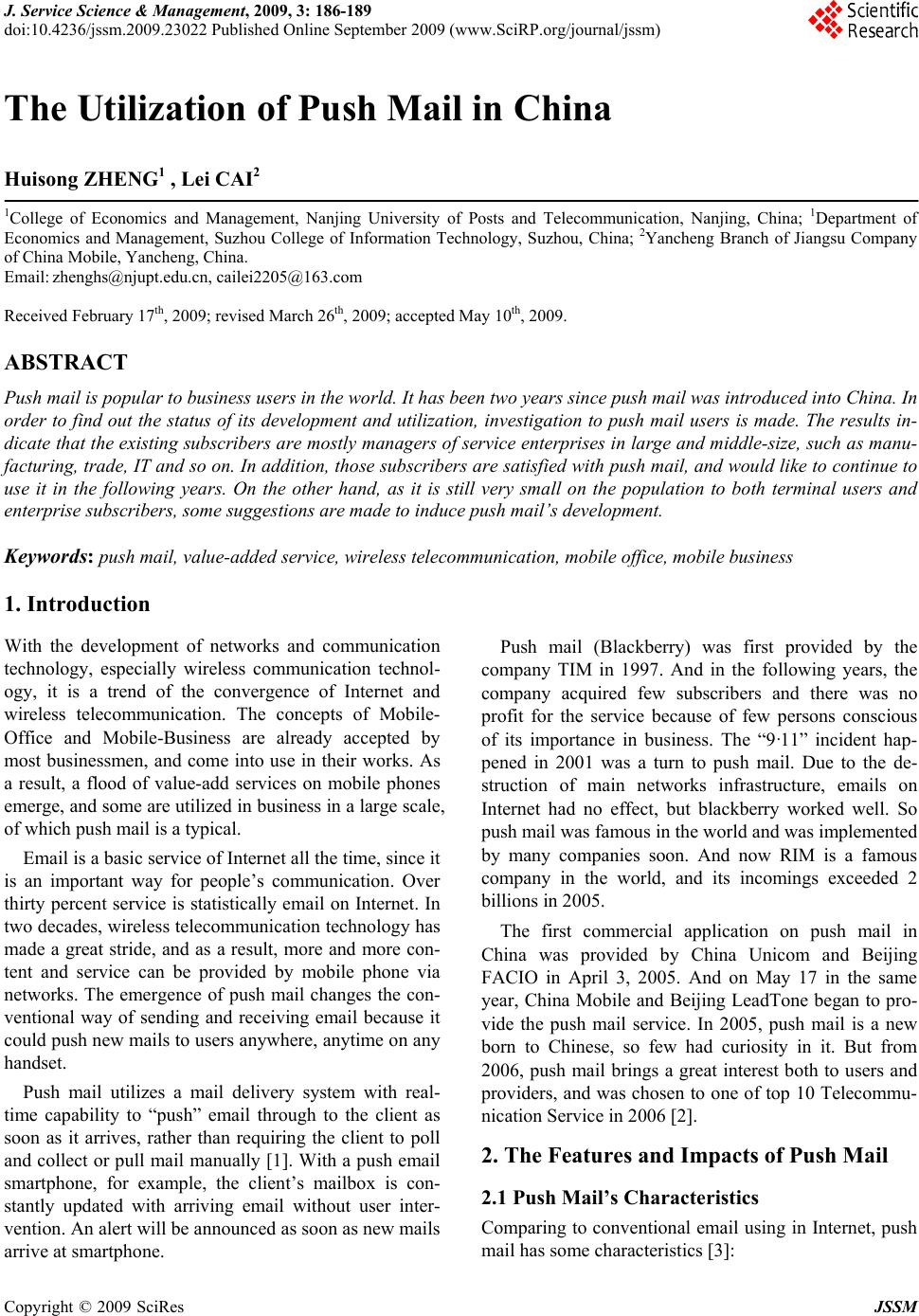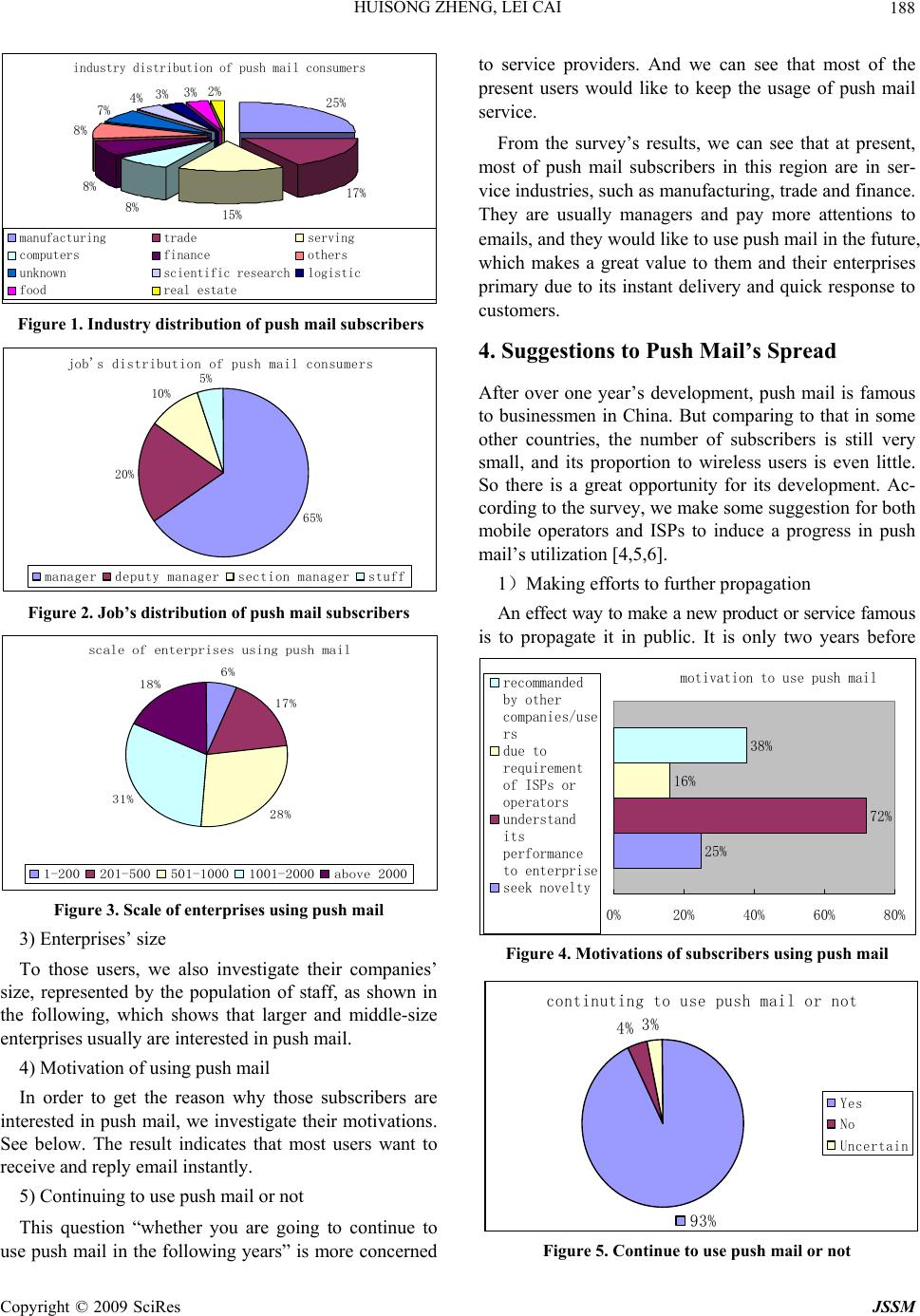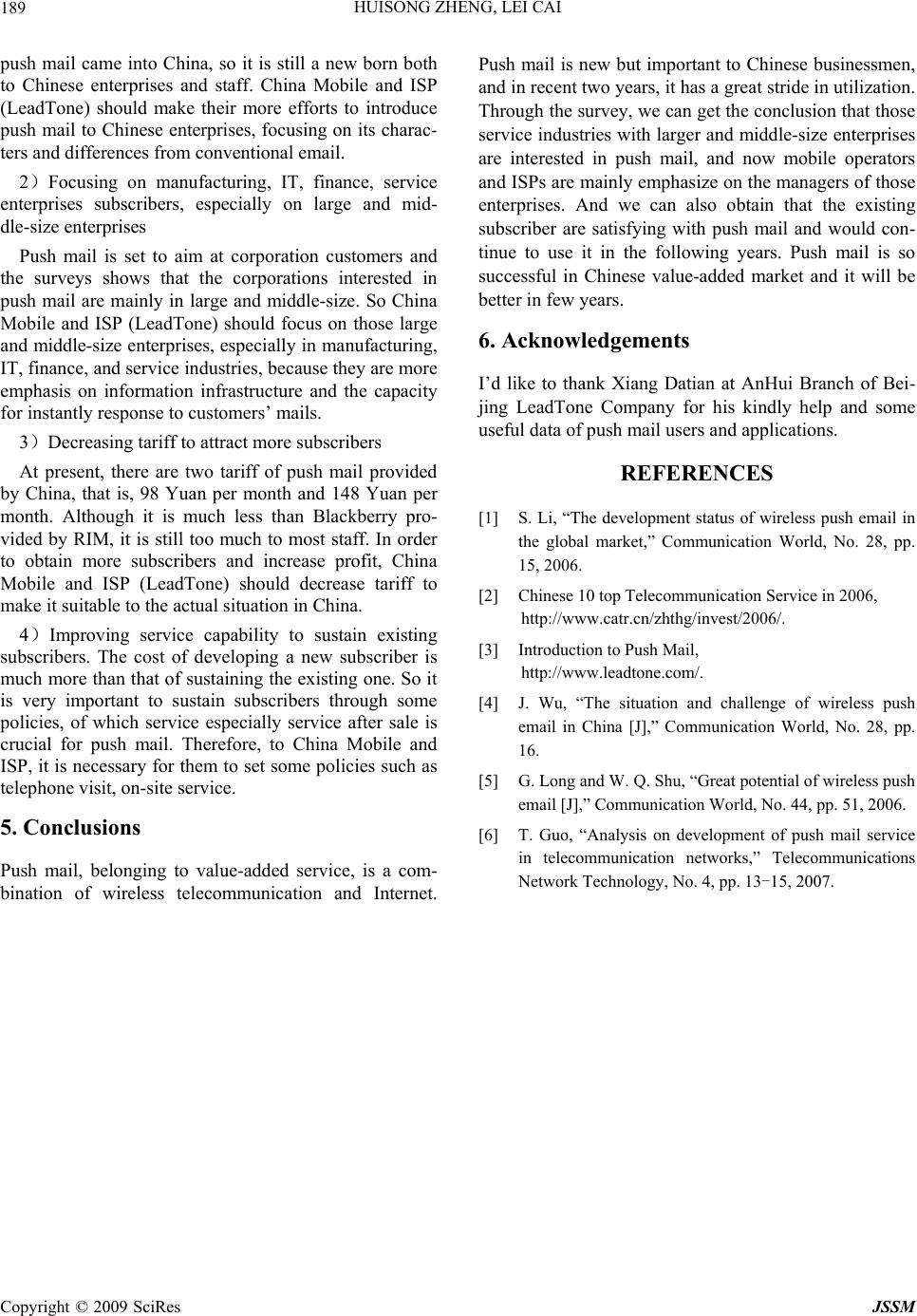Paper Menu >>
Journal Menu >>
 J. Service Scie nce & Management, 2009, 3: 186-189 doi:10.4236/jssm.2009.23022 Published Online September 2009 (www.SciRP.org/journal/jssm) Copyright © 2009 SciRes JSSM The Utilization of Push Mail in China Huisong ZHENG1 , Lei CAI2 1College of Economics and Management, Nanjing University of Posts and Telecommunication, Nanjing, China; 1Department of Economics and Management, Suzhou College of Information Technology, Suzhou, China; 2Yancheng Branch of Jiangsu Company of China Mobile, Yancheng, China. Email: zhenghs@njupt.edu.cn, cailei2205@163.com Received February 17th, 2009; revised March 26th, 2009; accepted May 10th, 2009. ABSTRACT Push mail is popu lar to business users in the world. It has been two years since push mail was introduced in to China. In order to find out the status of its development and utilization, investigation to push mail users is made. The results in- dicate that the existing subscribers are mostly managers of service enterprises in large and middle-size, such as manu- facturing, trade, IT and so on. In addition, those subscrib ers are satisfied with push mail, and would like to continue to use it in the following years. On the other hand, as it is still very small on the population to both terminal users and enterprise subscribers, some suggestions are made to induce push mail’s development. Keywords: push mail, value-added service, wireless telecommunication, mobile o ffice, mobile bu siness 1. Introduction With the development of networks and communication technology, especially wireless communication technol- ogy, it is a trend of the convergence of Internet and wireless telecommunication. The concepts of Mobile- Office and Mobile-Business are already accepted by most businessmen, and come into use in their works. As a result, a flood of value-add services on mobile phones emerge, and some are utilized in business in a large scale, of which push mail is a typical. Email is a basic service of Internet all the time, since it is an important way for people’s communication. Over thirty percent service is statistically email on Internet. In two decades, wireless telecommunication technology has made a great stride, and as a result, more and more con- tent and service can be provided by mobile phone via networks. The emergence of push mail changes the con- ventional way of sending and receiving email because it could push new mails to users anywhere, anytime on any handset. Push mail utilizes a mail delivery system with real- time capability to “push” email through to the client as soon as it arrives, rather than requiring the client to poll and collect or pull mail manually [1]. With a push email smartphone, for example, the client’s mailbox is con- stantly updated with arriving email without user inter- vention. An alert will be announced as soon as new mails arrive at smartphone. Push mail (Blackberry) was first provided by the company TIM in 1997. And in the following years, the company acquired few subscribers and there was no profit for the service because of few persons conscious of its importance in business. The “9·11” incident hap- pened in 2001 was a turn to push mail. Due to the de- struction of main networks infrastructure, emails on Internet had no effect, but blackberry worked well. So push mail was famous in the world and was implemented by many companies soon. And now RIM is a famous company in the world, and its incomings exceeded 2 billions in 2005. The first commercial application on push mail in China was provided by China Unicom and Beijing FACIO in April 3, 2005. And on May 17 in the same year, China Mobile and Beijing LeadTone began to pro- vide the push mail service. In 2005, push mail is a new born to Chinese, so few had curiosity in it. But from 2006, push mail brings a great interest both to users and providers, and was chosen to one of top 10 Telecommu- nication Service in 2006 [2]. 2. The Features and Impacts of Push Mail 2.1 Push Mail’s Characteristics Comparing to conventional email using in Internet, push mail has some characteristics [3]:  HUISONG ZHENG, LEI CAI 187 1) Timely: push mail, using push technology, pushes new mail to users’ wireless smartphones in time with an alert to inform users. 2) Mobility: push mail is a convergence of Internet and wireless technology, so comparing to email only receiving and sending through PC, it has an advantage of mobility, which makes users receive and send mails in any place, at any time. 3) Flexibility: push mail subscribers can define filter rules by themselves, and set black lists to prevent some specific mails. In addition, users can read a lot of types of annexes directly on smartphone, such as .pdf, .rar, doc, .xls, .ppt, .jpg, .wav and so on. 4) Security: the mail is transmit ted encrypted, only th e subscriber can read it using a special handset. Moreover all the mails are stored in users’ smartphone and backups in enterprise’ servers, so no one else can get it. If there is something wrong, for example, the smartphone is miss- ing, and the subs criber can delete all mails by the control of mail server. Therefore, it is safe to mails both in the transmission and storag e for subscribers using push mail. 2.2 Impacts to Users and their Enterprise 1) Instant delivery makes management effectiveness and increases enterprises’ competition advantage. In modern society, response to customers instantly is becoming an important factor to company’ success, es- pecially for service industries. Push mail service makes it possible. When email is sent by a customer, it soon ar- rives at the enterprise mail server, which immediately pushes the mail to client without waiting for polling. So it makes worker respond to custo mers in time, as a result it makes a good impression to customers due to little time delayed. 2) Cost saving for companies Currently, when you are away from your computer and want to check your email, you can use push mail or sign up to receive SMS (Short Message Service). The SMS is a wake-up call that Exchange Server sends through your mobile operator. In our country, you can either pay per message for each SMS notification you receive, or pay a monthly rate. But push mail is both a technology and service based on the combination of Internet and wireless telecommunication technology. And the cost of all contents provided by Internet is de- creasing, so push mail can save a lot of money for enter- prise. 3) Convenience Push mail uses “push” technology to timely send new mail to subscribers’ mobile phones, which need to be installed client software before, and been personalized subscribers requirements. So to those persons often out of office, especially managers, they don’t need to check email frequently while sending and receiving emails anywhere at any time. 3. Surveys on the Utilization of Push Mail in China In our country, email keeps a great growth in recent years partly because of the drive of networks infrastruc- ture and wireless telecommunication. And it becomes an important profit point for network economy, and in turns forces the sustaining and fast development of network economy. As surveyed, email is a service using the most frequently for internet users, and there is more than 162 million email users in China ended on June 30, 2007. Further more, the popularity of subscribers using mobile phone reaches at 250 million, of which more than 4 mil- lion uses smartphones. Push mail is deemed to a key application of new mobile data services due to its char- acters and advantages and it is favored by mobile opera- tors and network providers because of convergence of mobile business and value-added service. At present, both two mobile operators have imple- mented push mail service. But the services they provide have a lot differences. The Redberry provided by China Unicom is a service extending from MMS (Multimedia Messaging Service) and mainly applies for individual consumers, while the service offered by China Mobile aims at enterprise customers. China Mobile now can provide push mail service in 29 cities of the co untry, and it has acquired a population of about 100 thousand ter- minal subscribers and 20 thousand enterprise customers in only one year. In order to find out the u tilization statu s of push mail service in our country, and the impacts to enterprises’ performance, we survey some consumers using push mail provided by China Mobile in a specific region, which focuses on the consumers’ industry distri- bution, job position, motivation and the enterprise’s size and so on. 1) Industry distribution The survey shows that push mail users in this region concentrate on manufacturing, tr ade and service Indu s tr ie s, and their summation is approximately two third in the total market. 2) Subscribers’ job distribution From the data, we can see that the users of push mail are mainly managers, especially for those in charge of IT, sales and marketing, who may be out of office and their computers frequently. Copyright © 2009 SciRes JSSM  HUISONG ZHENG, LEI CAI 188 industry distribution of push mail consumers 25% 17% 15% 8% 8% 8% 7% 4% 3% 3% 2% manufacturing tradeserving computers financeothers unknown scientific researchlogistic food real estate Figure 1. Industry distribution of push mail subsc r i be r s job's distribution of push mail consumers 65% 20% 10% 5% managerdeputy managersection managerstuff Figure 2. Job’s distribution of push mail subscribe r s scale of enterprises using push mail 6% 17% 28% 31% 18% 1-200201-500501-10001001-2000above 2000 motivation to use push mail 25% 72% 16% 38% 0%20% 40% 60% 80% recommanded by other companies/use rs due to requirement of ISPs or operators understand its performance to enterprise seek novelty Figure 3. Scale of enterprises using push mail 3) Enterprises’ size To those users, we also investigate their companies’ size, represented by the population of staff, as shown in the following, which shows that larger and middle-size enterprises usually are interested in push mail. continuting to use push mail or not 4% 3% 93% Yes No Uncertain 4) Motivation of using push mail In order to get the reason why those subscribers are interested in push mail, we investigate their motivations. See below. The result indicates that most users want to receive and reply email instantly. 5) Continuing to use push mail or not This question “whether you are going to continue to use push mail in the following years” is more concerned to service providers. And we can see that most of the present users would like to keep the usage of push mail service. From the survey’s results, we can see that at present, most of push mail subscribers in this region are in ser- vice industries, such as manufacturing, trade and finance. They are usually managers and pay more attentions to emails, and they would like to use push mail in the future, which makes a great value to them and their enterprises primary due to its instant delivery and quick response to customers. 4. Suggestions to Push Mail’s Spread After over one year’s development, push mail is famous to businessmen in China. But comparing to that in some other countries, the number of subscribers is still very small, and its proportion to wireless users is even little. So there is a great opportunity for its development. Ac- cording to th e survey, we make some suggestion for both mobile operators and ISPs to induce a progress in push mail’s utilization [4,5 ,6]. 1)Making efforts to further propagation An effect way to make a new product or service fa mou s is to propagate it in public. It is only two years before Figure 4. Motivations of subscribe r s using pus h mail Figure 5. Continue to use push mail or not Copyright © 2009 SciRes JSSM  HUISONG ZHENG, LEI CAI Copyright © 2009 SciRes JSSM 189 push mail came into China, so it is still a new born both to Chinese enterprises and staff. China Mobile and ISP (LeadTone) should make their more efforts to introduce push mail to Chinese enterprises, focusing on its charac- ters and differences from conventional email. 2)Focusing on manufacturing, IT, finance, service enterprises subscribers, especially on large and mid- dle-size enterprises Push mail is set to aim at corporation customers and the surveys shows that the corporations interested in push mail are mainly in large and middle-size. So China Mobile and ISP (LeadTone) should focus on those large and middle-size enterprises, especially in manufacturing, IT, finance, and service industries, because they are more emphasis on information infrastructure and the capacity for instantly response to customers’ mails. 3)Decreasing tariff to attract more subscribers At present, there are two tariff of push mail provided by China, that is, 98 Yuan per month and 148 Yuan per month. Although it is much less than Blackberry pro- vided by RIM, it is still too much to most staff. In order to obtain more subscribers and increase profit, China Mobile and ISP (LeadTone) should decrease tariff to make it suitable to the actua l situation in China. 4)Improving service capability to sustain existing subscribers. The cost of developing a new subscriber is much more than that of su staining the existing one. So it is very important to sustain subscribers through some policies, of which service especially service after sale is crucial for push mail. Therefore, to China Mobile and ISP, it is necessary for them to set some policies such as telephone visit, on-site service. 5. Conclusions Push mail, belonging to value-added service, is a com- bination of wireless telecommunication and Internet. Push mail is new but important to Chinese businessmen, and in recent two years, it has a great stride in utilization. Through the survey, we can get the conclusion that tho se service industries with larger and middle-size enterprises are interested in push mail, and now mobile operators and ISPs are mainly emphasize on the managers of those enterprises. And we can also obtain that the existing subscriber are satisfying with push mail and would con- tinue to use it in the following years. Push mail is so successful in Chinese value-added market and it will be better in few years. 6. Acknowledgements I’d like to thank Xiang Datian at AnHui Branch of Bei- jing LeadTone Company for his kindly help and some useful data of push mail users and applications. REFERENCES [1] S. Li, “The development status of wireless push email in the global market,” Communication World, No. 28, pp. 15, 2006. [2] Chinese 10 top Telecommunication Service in 2006, http://www.catr.cn/zhthg/invest/2006/. [3] Introduction to Push Mail, http://www.leadtone.com/. [4] J. Wu, “The situation and challenge of wireless push email in China [J],” Communication World, No. 28, pp. 16. [5] G. Long and W. Q. Shu, “Great potential of wireless push email [J],” Communication World, No. 44, pp. 51, 2006. [6] T. Guo, “Analysis on development of push mail service in telecommunication networks,” Telecommunications Network Technology, No. 4, pp. 13-15, 2007. |

